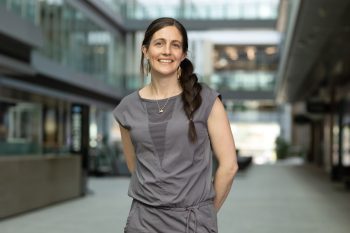
Through startups and partnerships, leading researchers from U of T Engineering’s labs, centres and affiliated hospitals are commercializing cutting-edge technology and revolutionizing the current state of health care. Click on the icons below to explore six of these promising technologies, originally shared in the 2014 issue of Skulematters.
Technology that kick-starts your heart
Like a scene lifted from Frankenstein, Professor Milica Radisic’s (IBBME, ChemE) “biowire” platform treats immature human cardiac cells, derived from stem cells, to cycles of electric pulses—a process that encourages growth at the same rate as a developing fetus. The result: mature heart tissue that meets a major need in the pharma industry, which, until now, has been unable to test medications on live human heart tissue. Grown along sutures, the heart tissue may also eventually be developed as cardiac patches that, derived from a patient’s own cells, won’t cause rejection issues. Radisic is currently developing the commercial possibilities of this remarkable technology.
Timing is everything: rethinking hospital schedules
When you’re running a medical facility designed to keep people out of the hospital, flawless scheduling is vital. Last year, when Women’s College Hospital was in the process of moving its outpatient operations to a new building in Toronto, the Centre for Healthcare Engineering (CHE), housed within the Department of Mechanical and Industrial Engineering (MIE), helped them to re-think their schedule to see how they could improve their operations. “We developed a new mathematical model that would generate optimized schedules,” said Professor Timothy Chan (MIE), newly appointed director of the CHE. The resulting software, which improved the effective use of treatment space within the hospital leading to better utilization and fewer cancellations, has the potential to revolutionize hospital operations everywhere.
A little zap goes a long way: electrical stimulation therapy
Imagine an electrical stimulation therapy for the treatment of arm and hand paralysis after a stroke or spinal cord injury, evidenced to have massive long-term gains over traditional therapies. You’ve just imagined MyndMove: the premiere product of Professor Milos Popovic’s (IBBME) startup MyndTec, founded with Professor Aleksandar Prodic (ECE), Armen Baronijan (ECE MASc 9T4, PhD 9T8) and U of T alumna Diana Pliura. In trials, patients consistently reached and sustained the top range of two of the most common motor function and activity of daily living independence tests. MyndTec won a Health Canada medical device license in the spring of 2014, giving the company the green light to advance its product to the market. Next steps: training medical personnel on the device and fine-tuning the product for market readiness before changing the outcomes of millions of patients.
Recipe for regeneration: injectable hydrogel
It’s derived from ingredients found in wrinkle creams and eye droplets, but University Professor Molly Shoichet (ChemE, IBBME) is cooking up a different recipe: an injectable hydrogel—a water-containing material that is biocompatible—for stem cell transplantations. Studies show that the hydrogel at least doubles the survival rate of stem cells injected with it, and early results show promise of tissue repair. Shoichet aims to commercialize the hydrogel and is testing it in key applications with clinical collaborators.
Tremors? There’s an app for that
A common sign of alcohol withdrawal is tremor of the hands and arms—a symptom that can be underestimated, leading to further health problems, or faked to gain access to prescription medication. But a new mobile app, developed by Professor Parham Aarabi (ECE), PhD candidate Narges Norouzi (ECE MASc 1T4) and Professor Bjug Borgundvaag of the Faculty of Medicine, aims to provide front- line health-care workers with the objective data they require to guide diagnosis and treatment decisions. To use, patients simply hold an iPod equipped with the app with both hands for 20 seconds while the device’s built-in accelerometer measures the frequency and severity of the tremor. While still a pilot project, the app has immense potential on a global scale.
Let it flow: dialysis biomaterial
Endexo is a little polymer making a big splash for Professor Paul Santerre’s (IBBME) startup, Interface Biologics, Inc. Blended into medical materials, the biomaterial proves extremely effective at preventing blood clots in catheter applications— from drug delivery to dialysis. Since receiving FDA regulatory approval in 2012, Endexo has been licensed by AngioDynamics for the BioFlo PICC catheter. Used in kidney dialysis catheters, the special biomaterial does away with the need for blood-thinning agents. The product has netted over 30 per cent of AngioDynamic’s new revenues in recent quarterly reports, and accounts for a growing margin of U.S. catheter sales. A central venous catheter containing Endexo, for use in long-term medication or fluid delivery, is also now available from AngioDynamics.



